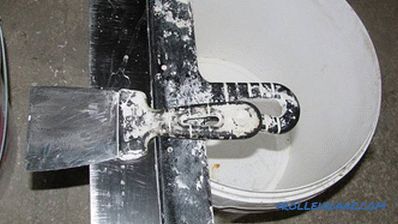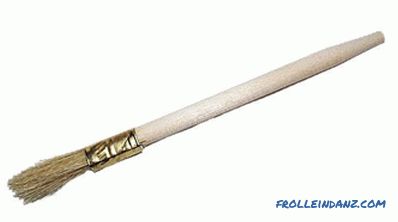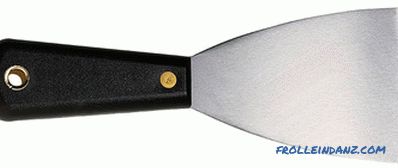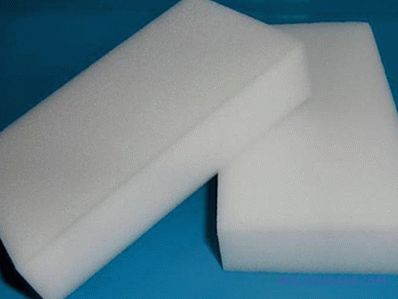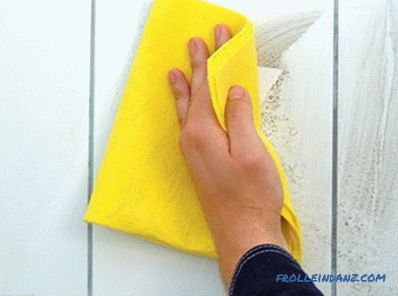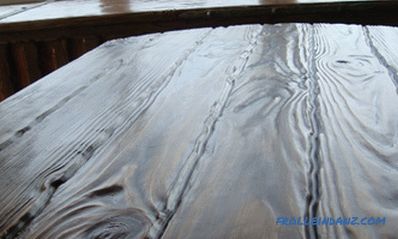Having tiled the bathroom, it is necessary to perform one more step - to wipe the seams, because not only the aesthetic appearance of the whole room depends on it, the durability of the finish is ensured due to the absence of mold or fungus. Self-trowel tile in the bathroom is quite feasible task.
How to choose high-quality grouting
First of all, you need to choose a mixture with regard to its composition. Consider the types of grout.
| Grout | Composition |
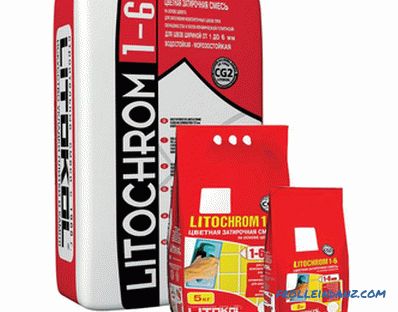 Cement fugue Cement fugue | Most of the fugue is sold in powder form, the composition of which includes portland cement, plasticizers and fine sand. If necessary, added pigment components that provide the desired color. |
 Latex additive for grouting Latex additive for grouting | Latex the grout is more perfect and is one of the varieties of mastics. The mixture contains latex components, due to which the ready-made mixture is elastic and moisture-resistant, which is an indisputable advantage, since the moisture does not penetrate into the seams. No problem, you can choose the right color and even shade. |
 Epoxy Grout Diamond Epoxy Grout Diamond | Except resin, in the composition of the epoxy grout is and hardener. After hardening, the composition becomes very durable and waterproof. With regard to the selection of a suitable shade, then there will be no problems, as there are many coloring pigments designed for such grouting. |
 Silicone Grout-Sealant Silicone Grout-Sealant | Silicone The grout is waterproof and frost-resistant, therefore it is used on balconies and terraces, as well as in rooms with high humidity. Resistant to ultraviolet radiation. Used for sealing seams from 2–7 mm. |
| Furan-based grout | The furan grout is not dangerous for aggressive environments. Due to the nature of the composition, the grout can only be black, so it is most often used on industrial sites and very rarely in residential areas. |
You can buy grout in the form of a paste, but more often it is sold in the form of dry mixes, packaged in 1 kg each, in small, dense packages. Grouting can be one- or two-component, for example, polymer-cement or cement-sand.
In addition to the composition, the grout differs in the setting speed. It can be said with confidence that for an inexperienced person who works rather slowly, this factor is of no small importance. If there is some experience, then this criterion is not so important.
You can also make a grout from sodium "liquid glass", gypsum, alabaster, and other materials, but it is important to realize that the quality of the prepared mixture may not be at the highest level.
How to do the grouting with your own hands
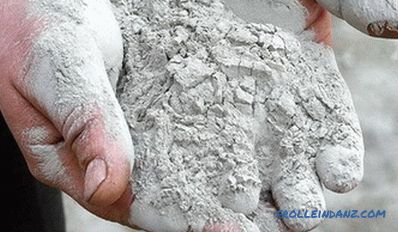 Making homemade grout
Making homemade grout
The process of making homemade grouting is not complicated, and it can be made by any person.
Cement-sand mixture
To determine the composition, it is necessary to know the width of the seams between the laid tiles.
- The seam width is no more than 1.5 mm. We take Portland cement as a base (white can be used) by adding a latex or other suitable additive to it. The mixture can be made in color by adding a water-soluble color.
- The seam is in the range of 1.5-3 mm. Portland cement in a 1: 1 ratio is mixed with fine sand.
- The seam is 3-12 mm. Re-use Portland cement, only with larger sand, and its grit increases in proportion to the increase in the width of the joint.
These data should not be taken as an inviolable axiom - these are just averaged data that may have to be corrected in the process of using the trowel mixture.
Alabaster or gypsum
These two materials are not the same as it may seem at first glance, but these materials have something in common - they very quickly set, but slow down the process You can add some PVA glue or lime paste to it. Kneading a small amount of alabaster, you need to use it for a few minutes, otherwise it will harden and become unusable, and you can’t re-dilute it with water. Accordingly, it is necessary to clean the tile from the remnants of the solution immediately.
Liquid glass
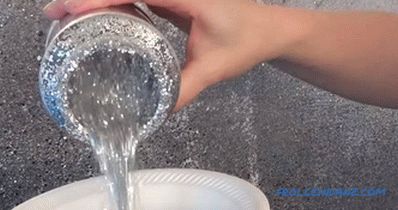 Adding sparkles to liquid glass
Adding sparkles to liquid glass
To make such a grout , enough to mix liquid glass with sparkles. The resulting composition will highlight the seam, highlighting the beauty of the tile.
Clay
Of course, this material is not particularly strong and, moreover, very hygroscopic, but with a skillful approach it will cope well with the function assigned to it. Clay should be properly prepared, going through, clearing from various debris. Then it needs to be soaked so that it becomes plastic.After thoroughly knead the mass, add a little cement and lime to it, about 100 g per 1 kg of clay - these components will make the grout made more plastic and strong. By the way, clay can be of different colors, so the choice, although small, is still there, and if you want you can add a little color to the composition.
What should be considered when choosing a grout
So, having a little understanding of what kind of grout there is, we will try to make the right choice, taking into account some factors.
Type of room
In which room is the tile laid and where is it on the floor or on the wall? The answer to this question will help clarify a lot.
Room feature
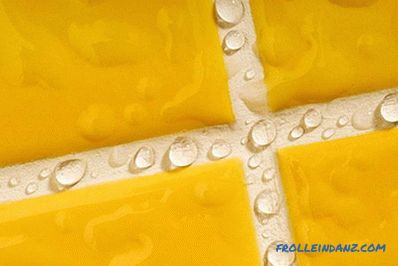 Grout for the bathroom must be moisture resistant
Grout for the bathroom must be moisture resistant
In this room the humidity is the highest, so a cement-based fugue would not be the best choice for grouting joints between tiles. Not only will such a composition absorb moisture, it will also begin to crumble, especially when using low-grade cement. By adding latex additives, the quality of grouting can be significantly improved, but it is better to use mixtures based on liquid glass or epoxy resin.
Floor
 Grouting on the floor should not be washed out
Grouting on the floor should not be washed out
In any room it’s laid on the floor, the tile is subjected to intense load, so it has to be washed frequently and sometimes even brushed with a stiff brush. This is a good reason for not using cement-based grouting, as this compound is not water resistant, and weak. When using resin materials, you can not worry about the durability of the applied grouting and the method of wet cleaning.
Typically, the shelf life is not more than 6 months. After this period, the quality of the fugue deteriorates markedly - it hardens and loses plasticity. It is also important to be extremely careful not to get a cheaper low-grade fake.
A suitable color
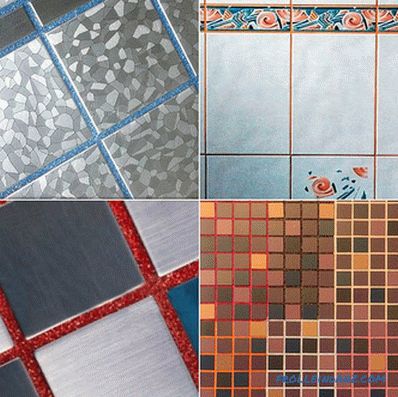 Even the use of contrasting shades should not cause disharmony
Even the use of contrasting shades should not cause disharmony
To buy high-quality fugu and properly wipe the seams is not all, because its color must be in harmony with the tile or create a sharp contrast - this depends on the chosen style and preferences of the owner of the room. Consider 3 design directions.
- The most commonly used grout is white color, because it fits almost any tile. This neutral color is in harmony with both light and dark shades of wall or floor tiles. Thanks to its use, a feeling of solidity is created, or vice versa - the contours of a darker tile will be emphasized.
- Also the grout can be selected in the tone of the laid (or acquired) tile. The fugue may be of exactly the same color or its shade may differ slightly. The second option is more common, as it allows to make the finish more expressive. It is rather difficult to choose a grout of the same color as the tile, but even if it worked out, there is no guarantee that the tint of the fugue will not change over time.
 Using red grout for joints
Using red grout for joints
- If you need to finish it contrasting , the color of the grout should be qualitatively different from the color of the tile. For example, the seams between black tiles can be wiped with a white fugue (or vice versa - the seams between white tiles can be wiped with a dark composition), and it will look, while the combination of other shades is not always harmonious.
 Options for grout colors
Options for grout colors
At first glance, it may seem that it is not difficult to choose fugu suitable color, but having come to the store, you can get confused when faced with a huge choice. To avoid this, it is better to look at the design options for the bathroom.
Bathroom Photos
 The completed grout gently emphasized the contrast
The completed grout gently emphasized the contrast
 In this bathroom, a single-color grout was used
In this bathroom, a single-color grout was used
 Light grout on the background of purple tile
Light grout on the background of purple tile
 Used dark grout
Used dark grout
 The fugue is matched to the tone of the furniture
The fugue is matched to the tone of the furniture
 A fugue of the same color
A fugue of the same color
 White fugue on a background of green tile
White fugue on a background of green tile
 A white fugue
A white fugue
 is used to grout tiles of different shades Naya Fugue does not fit
is used to grout tiles of different shades Naya Fugue does not fit
 The fugue is matched to the tile
The fugue is matched to the tile
 A universal white fugue
A universal white fugue
 Used for grouting only white fugue
Used for grouting only white fugue
 The seams of the black tile are wiped with white grout
The seams of the black tile are wiped with white grout
 A white fugue
A white fugue
 is applied to both the dark and white tiles. The use of a white fugue made it possible to make a wall as if it was made of brick
is applied to both the dark and white tiles. The use of a white fugue made it possible to make a wall as if it was made of brick
 The fugue matches the tone in the bathroom tile
The fugue matches the tone in the bathroom tile
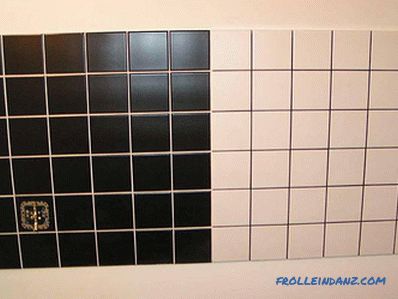 Contrast grouting of the seams of the tile
Contrast grouting of the seams of the tile
So, based on the design you like, let's go to the store. Of course, if you wish, you can buy a grout in the online store, but it is important to remember that its color on the monitor screen can be distorted. For example, a light brown fugue may in fact turn out to be bright red, etc. Given this nuance, we will focus on the first option.
- In order to select a fugu suitable for the color, you need to take a couple of tiles or pieces left after the lining, otherwise there is nothing left from the old confidence that you remember the color of the tile.
- Do not succumb to the persuasion of the seller or consultant to acquire the "hit of the season" - an unusual color, fashionable grout or a shade that you don’t like.
- Please note that the manufacturer you like may not produce the fugu of the desired shade.
- It is imperative that you check the release date on each package.
Of course, you will need to calculate the grout consumption for tile joints per 1 m 2 , which can be done on our online calculator.
Video: the nuances of choosing the right grout for tile
Preparing the tool for work
The quality and speed of the work is directly dependent on the available tool.
| | Although most often only 1 rubber trowel is selected for work, it is better to purchase a kit, and then choose the one that is most convenient for you to work with. |
| | Since the batch volume is small, a small plastic bucket from any building mix will do. After completion of the grouting, the container must be thoroughly cleaned, otherwise the dried-up pieces of the old fugue will be in the new composition. |
| | This tool is very easy to use, as with its help the work is done quickly and efficiently. When removing old grouting, you can combine actions - first clean the seam with a hacksaw blade, and then with a special knife for clearing the seams. |
| | A narrow paint brush is more convenient to use, but it is better if it is tough enough so that you can thoroughly clean the seams. |
| | The spatula does not need to choose the narrowest - 35-50 mm is enough. |
| | Foam sponge choose high density. Often used sponge for washing dishes. |
| | There is a different soft fabric, but we need one that absorbs water well. The acquired dishcloth is ideal. |
| | Many blends can irritate your skin, so it’s best to work in thick rubber gloves |
| | Protective mask is needed both when mixing a new mixture, and when removing the old one. |
The process of grouting tiles in the bathroom
With all the tools you need, you can begin to grout the joints. Consider the stages of the work.
Stage 1.Cleaning seams
 Cleaning seams
Cleaning seams
No matter how hard we try, after laying the tile between it glue remains with seams, and it cannot be delayed with its removal; otherwise, when the glue dries, it will become a very laborious process. To perform the work it is best to use a knife to clean the tile joints. You need to clear the entire depth of the seam, and not just to the base of the tile. At the end of the work, the seams must be cleaned with a brush so that there is no trash left in them. To speed up the process, you can use a vacuum cleaner.
Step 2. Preparing the mix
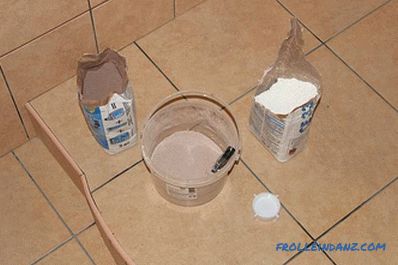 Preparing the grout for the tile
Preparing the grout for the tile
If purchased ready for use grout, then it can immediately be used, but the dry mixture should be prepared. To do this, some water is poured into the container (according to proportions), and then the dry mixture is added and the whole mixture is stirred with a metal spatula. The solution should turn out like thick cream and no lumps. If glitter is added to the mixture, it is necessary to measure a certain amount each time so that the seams do not visually differ from each other.
If the mixture hardens for quite a long time, then it can be kneaded in larger quantities. In this case, it will be convenient to use a mixer.
Stage 3. Grouting joints
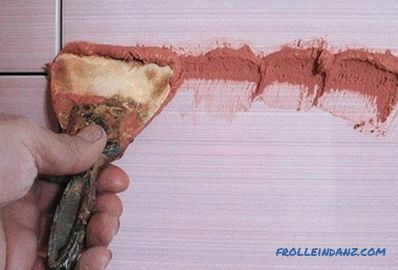 The primary application of the grout is across the joint
The primary application of the grout is across the joint
Before starting to grout, the joints should be moistened with an antiseptic primer or water with a spray gun. If there is none, then you can use the same small brush, occasionally dipping it into the liquid poured into the bucket.
The process of grouting itself consists in the fact that you need not to cover the seams with a plow, but to wipe it with force, trying to make it fill all voids. Therefore, it does not need to be spread over the entire tile; it is only necessary to apply with a rubber trowel across the seam. It is better not to take up more than 2 m 2 at a time.
 Using a rubber trowel, removing the remnants of a fugue him and taking off the excess fugues.
Using a rubber trowel, removing the remnants of a fugue him and taking off the excess fugues.
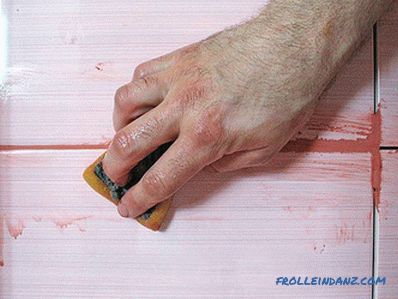 Excess fugues are removed with a damp sponge
Excess fugues are removed with a damp sponge
After waiting a little while for the grout to grab, the surplus is removed with a damp sponge . There is no need to press - the goal is not only to clean the tile, but to even out the grout layer in the seam, so the movements should be light.
 We rub the tile with a soft cloth
We rub the tile with a soft cloth
The grout should harden a little, but not dry, after which the tile can be Wipe dry with a soft cloth.
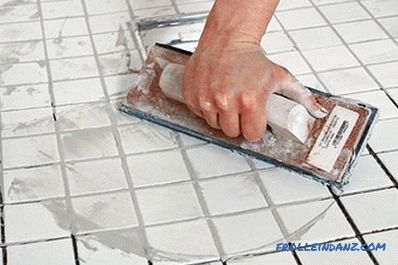 In this case, you can work with a wide trowel
In this case, you can work with a wide trowel
When rubbing the seams of non-relief tiles of small size, you can rub the fugue wide spatula. In this case, a less thick mixture is used. The following procedure does not differ from that described above.
How to replace the grout with a new
 Removing old grout from the joints with a knife for
Removing old grout from the joints with a knife for
Most often, grouting of old cement-based joints needs replacing. Since its lifespan is short, it can crumble or marvel at the fungus. Unfortunately, the seam of newly laid grout can crack because the corresponding conditions have not been created, for example:
- Too much water has been added to the composition.
- The density of the tile is not taken into account - the porous material quickly absorbs moisture from the fugue, because of which it dries very quickly.
- The base is not stable. In this case, the cement-based fugue will constantly crack, no matter how much it is changed.
- The grout for the wide joint is incorrectly selected.
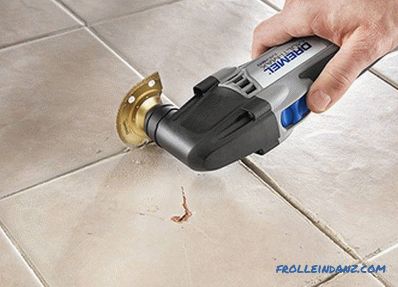 Removing the old fugue from the seams
Removing the old fugue from the seams
There may be other reasons (maybe you need make a seam of a different color), but we brought the main. Now consider what you need to do to wipe the seams of the new fugue.
So, we need to remove the old grout. How best to do this, learn from the following video.
Video: removing the old grout
As you could understand, the process is simple but time consuming.
When cleaning the seams from the old grout, be careful near the corner seams, being careful not to cut off the slightly protruding part of the tile - in these places you need to do the work with particular care.
Protect your eyes from flying pieces of dried fugues, wear safety glasses.
Just as in the case of newly laid tiles, the seams need to be cleaned, moistened, and then rub in the fresh composition of the freshly prepared grout.
Video: working with epoxy and cement grout

